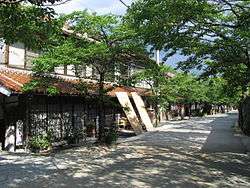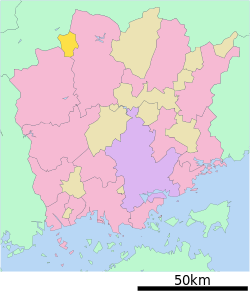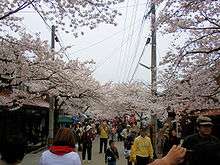Shinjō, Okayama
Shinjō (新庄村, Shinjō-son) is a village located in Maniwa District, Okayama Prefecture, Japan.
Shinjō 新庄村 | |
|---|---|
Village | |
 Shinjō village | |
Flag Chapter | |
 Location of Shinjō in Okayama Prefecture | |
 Shinjō Location in Japan | |
| Coordinates: 35°11′N 133°34′E | |
| Country | Japan |
| Region | Chūgoku San'yō |
| Prefecture | Okayama Prefecture |
| District | Maniwa |
| Area | |
| • Total | 67.1 km2 (25.9 sq mi) |
| Population (January 31, 2017) | |
| • Total | 951 |
| • Density | 14/km2 (37/sq mi) |
| Time zone | UTC+9 (JST) |
| Website | www |
In March 2017, the village had an estimated population of 951 and a density of 14 persons per km².[1] The total area is 67.1 km².
This village is known for the cherry trees along its main street, which is called Triumphal return Cherry Blossom Street (がいせん桜通り, Gaisen sakura dōri). These trees were planted to celebrate the Japanese victory over the Russians in the Russo-Japanese War in 1905.
There are many old buildings along Victory Cherry Blossom Street. Many of these buildings used to be hotels that were built to accommodate the sankin kōtai annual mandatory processions of feudal lords from their domains to the capital and back. It is also said that Emperor Go-Toba passed this way in exile on his way to an island in the Sea of Japan where he died.
Shinjō grows a variety of rice called hime no mochi. This rice is used to make the mochi rice cakes for which this town is also known. The hime no mochi factory is a major employer in Shinjō.
References
- "Official website of Shinjō village" (in Japanese). Japan: Shinjō village. Retrieved 15 April 2017.
External links
| Wikivoyage has a travel guide for Shinjo (Okayama). |

- Shinjō official website (in Japanese)
